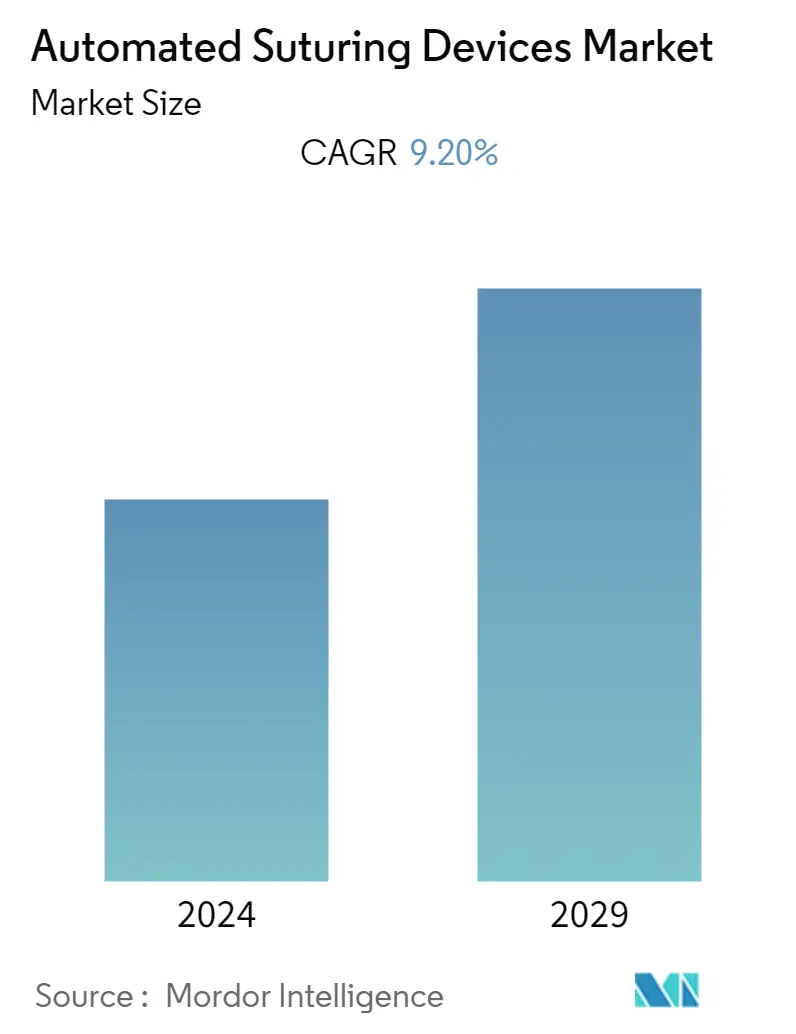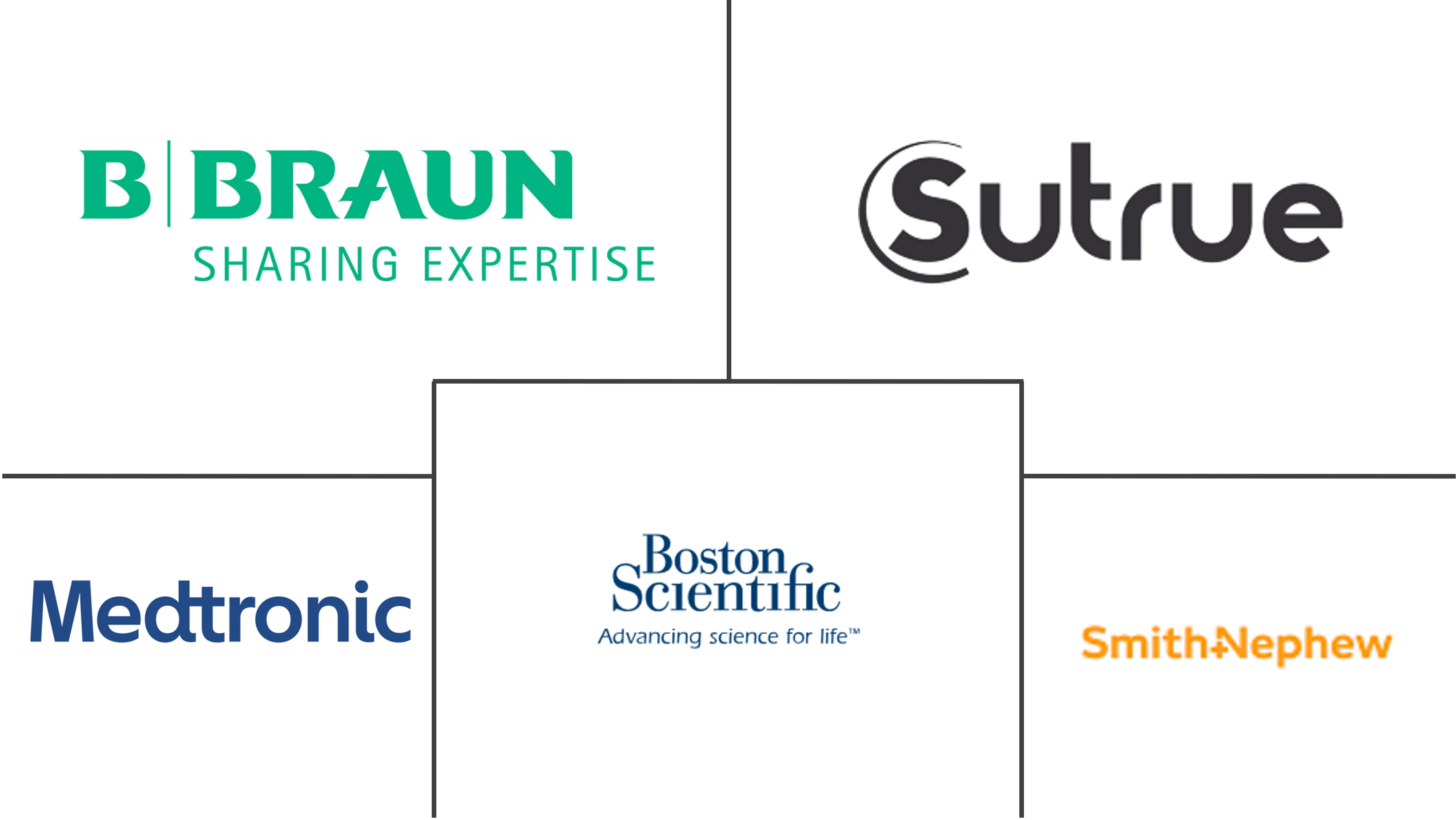Market Size of Automated Suturing Devices Industry

| Study Period | 2019 - 2029 |
| Base Year For Estimation | 2023 |
| CAGR | 9.20 % |
| Fastest Growing Market | Asia Pacific |
| Largest Market | North America |
| Market Concentration | Medium |
Major Players
*Disclaimer: Major Players sorted in no particular order |
Automated Suturing Devices Market Analysis
The automated suturing devices market is projected to register a CAGR of 9.2% during the forecast period.
The healthcare system has witnessed enormous challenges due to the COVID-19 pandemic. All outpatient treatments were postponed or restricted during the COVID-19 pandemic to reduce the risk of viral transmission, as most chronic therapies were regarded as non-urgent. During the COVID-19 pandemic, the implementation of digital technologies in the hospital sector increased significantly due to the lack of healthcare personnel. An article published in the Seminars in Vascular Surgery journal in September 2021 discussed the acceptance and acceleration of telemedicine, remote monitoring, digital health technology, and three-dimensional technologies, such as three-dimensional printing and virtual reality, face-to-face surgical simulation, and training. The article indicated that automated surgical devices have risen during the COVID-19 pandemic. Such developments during the COVID-19 pandemic are expected to propel the growth of the automatic suturing devices market. Automated suturing devices have demonstrated the ability to enhance health outcomes during the pandemic, hospitals realize the advantage of automated suturing devices over manual suturing devices. Hence, the demand for automated suturing devices increased, eventually driving market growth.
The recent increase in the number of surgeries and the rise in the number of accident and trauma cases all over the world are the major factors attributing to the growth of the automated suturing devices market in the forecast period. According to the Royal College of Surgeons of England data on the surgeries in England published in May 2021, there were around 4.95 million people in England waiting for surgery. The large number of surgeries to be performed is expected to add to the growth of the automated suturing devices market in the forecast period. Additionally, according to the World Health Organization data on Road Traffic Injuries published in June 2021, around 20 to 50 million people suffer from nonfatal injuries, most of which require surgery for treatment. Such a large number of accidents requiring surgeries are expected to boost the growth of the automated suturing market in the forecast period.
Moreover, in January 2022, Endomina, an endoscopic medical suture device developed by Endo Tools Therapeutics, was approved by the United States Food and Drug Administration for endoscopic placement of sutures in the gastrointestinal tract in adult population.. Such developments for automated sutures are likely to amplify the growth of the automated suturing devices market in the forecast period.
Therefore, the factors mentioned above are attributed collectively to the studied market growth over the forecast period. However, the reduced product availability and the lack of skilled professionals, along with the high cost of the devices are likely to hinder the growth of the automated suturing devices market in the forecast period.
Automated Suturing Devices Industry Segmentation
As per the scope, automated suturing devices facilitate suturing procedures during minimally invasive surgery and open surgery and are primarily used in surgical procedures and trauma cases requiring surgery. In most developed countries, automated suturing is preferred over conventional suturing as it enables better wound healing and decreases the hospital stay duration of patients post-surgery. The automated suturing devices market is segmented by product type (disposable and reusable), application (cardiovascular, gynecological, gastrointestinal, orthopedic, and others), and geography (North America, Europe, Asia-Pacific, Middle East and Africa, and South America). The market report also covers the estimated market sizes and trends of 17 countries across major regions globally. The report offers values (in USD ) for the above segments.
| By Product Type | |
| Disposable | |
| Reusable |
| By Application | |
| Cardiovascular | |
| Gynecological | |
| Gastrointestinal | |
| Orthopedic | |
| Others |
| Geography | ||||||||
| ||||||||
| ||||||||
| ||||||||
| ||||||||
|
Automated Suturing Devices Market Size Summary
The automated suturing devices market is poised for significant growth, driven by the increasing number of surgeries and trauma cases globally. The COVID-19 pandemic has accelerated the adoption of automated surgical devices, as hospitals sought to enhance efficiency and reduce manual intervention. This shift has highlighted the advantages of automated suturing devices over traditional methods, leading to increased demand. Innovations such as the FDA-approved Endomina device and developments in smart sutures are further propelling market expansion. Despite challenges like reduced product availability and high costs, the market is expected to grow, with disposable automated suturing devices gaining traction due to their efficiency in surgical procedures.
North America is anticipated to maintain a substantial share of the automated suturing devices market, supported by favorable regulatory conditions and a high prevalence of surgeries related to cardiovascular disorders and obesity. The region's growing awareness and increasing surgical procedures due to road accidents contribute to market growth. The competitive landscape is characterized by the presence of both global and regional players, including Medtronic, Smith & Nephew, Inc., and Boston Scientific Corporation. Recent product launches and ongoing research and development efforts are expected to drive further advancements and market penetration during the forecast period.
Automated Suturing Devices Market Size - Table of Contents
-
1. MARKET DYNAMICS
-
1.1 Market Overview
-
1.2 Market Drivers
-
1.2.1 Increased Number of Surgical Procedures
-
1.2.2 Increase in Accidents and Trauma Cases
-
-
1.3 Market Restraints
-
1.3.1 Low Product Availability and High Cost of the Devices
-
1.3.2 Lack of Skilled Professionals
-
-
1.4 Porter's Five Forces Analysis
-
1.4.1 Bargaining Power of Suppliers
-
1.4.2 Bargaining Power of Buyers/Consumers
-
1.4.3 Threat of New Entrants
-
1.4.4 Threat of Substitute Products
-
1.4.5 Intensity of Competitive Rivalry
-
-
-
2. MARKET SEGMENTATION (Market Size by Value - in USD)
-
2.1 By Product Type
-
2.1.1 Disposable
-
2.1.2 Reusable
-
-
2.2 By Application
-
2.2.1 Cardiovascular
-
2.2.2 Gynecological
-
2.2.3 Gastrointestinal
-
2.2.4 Orthopedic
-
2.2.5 Others
-
-
2.3 Geography
-
2.3.1 North America
-
2.3.1.1 United States
-
2.3.1.2 Canada
-
2.3.1.3 Mexico
-
-
2.3.2 Europe
-
2.3.2.1 Germany
-
2.3.2.2 United Kingdom
-
2.3.2.3 France
-
2.3.2.4 Italy
-
2.3.2.5 Spain
-
2.3.2.6 Rest of Europe
-
-
2.3.3 Asia-Pacific
-
2.3.3.1 China
-
2.3.3.2 Japan
-
2.3.3.3 India
-
2.3.3.4 Australia
-
2.3.3.5 South Korea
-
2.3.3.6 Rest of Asia-Pacific
-
-
2.3.4 Middle East and Africa
-
2.3.4.1 GCC
-
2.3.4.2 South Africa
-
2.3.4.3 Rest of Middle East and Africa
-
-
2.3.5 South America
-
2.3.5.1 Brazil
-
2.3.5.2 Argentina
-
2.3.5.3 Rest of South America
-
-
-
Automated Suturing Devices Market Size FAQs
What is the current Global Automated Suturing Devices Market size?
The Global Automated Suturing Devices Market is projected to register a CAGR of 9.20% during the forecast period (2024-2029)
Who are the key players in Global Automated Suturing Devices Market?
Medtronic, Smith & Nephew, Inc. , Boston Scientific Corporation, Sutrue Limited and B. Braun SE are the major companies operating in the Global Automated Suturing Devices Market.

